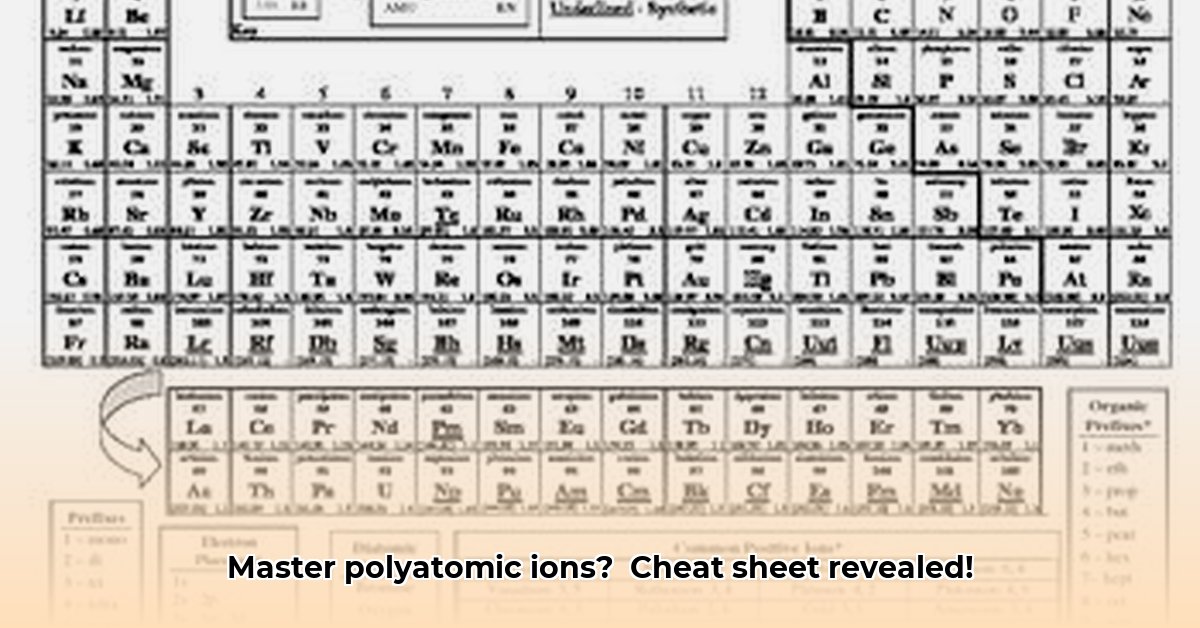
Mastering polyatomic ions—groups of atoms carrying a net charge—is crucial for success in chemistry. However, memorizing their formulas and charges can be challenging. This review compares two popular polyatomic ion cheat sheet approaches to help students and educators choose the most effective learning tool. We examine their strengths, weaknesses, and pedagogical implications, offering actionable advice for instructors, curriculum developers, and students. For a handy reference, check out this polyatomic ion chart.
Different Approaches to Learning Polyatomic Ions
Two distinct strategies emerge in the design of polyatomic ion cheat sheets: a visual approach and a nomenclature-based approach. These represent different pedagogical philosophies and cater to diverse learning styles.
Visual Learning: Cheat Sheet A
Cheat Sheet A employs a visual-centric strategy. It leverages diagrams, illustrations of molecular structures, and potentially animations to present information. This approach is particularly beneficial for visual learners who grasp concepts more readily through imagery. The engaging nature of visuals helps maintain student interest and facilitates comprehension of complex structures and concepts like resonance (the delocalization of electrons across multiple bonds). However, a purely visual approach might lack the depth needed for advanced topics or sufficient practice problems for mastery of complex nomenclature.
Nomenclature-Based Learning: Cheat Sheet B
Cheat Sheet B emphasizes a systematic, rule-based approach. It focuses on the IUPAC nomenclature (naming conventions) for polyatomic ions and provides numerous practice problems. This method is ideal for students who thrive in structured learning environments and benefit from repetition and problem-solving. The systematic approach allows for a deeper understanding of the underlying principles, but its less visual nature may not engage students who prefer a more dynamic presentation.
Comparative Analysis: Strengths and Weaknesses
The following table summarizes the key advantages and disadvantages of each cheat sheet type:
| Feature | Cheat Sheet A (Visual) | Cheat Sheet B (Nomenclature-Based) |
|---|---|---|
| Advantages | Engaging and intuitive; simplifies complex concepts; ideal for visual learners. | Systematic and organized; promotes memorization through practice; facilitates a thorough understanding of nomenclature. |
| Disadvantages | May lack depth for advanced topics; limited practice problems may hinder mastery. | Can be less engaging for visual learners; may not cater to all learning styles equally. |
| Best Suited For | Visual learners, beginners, introductory courses. | Students who prefer structure, problem-solving, and in-depth understanding. |
Key Differences and Areas of Convergence
Both cheat sheets cover fundamental aspects, including common polyatomic ions and basic nomenclature rules. However, their strengths diverge. Cheat Sheet A excels at visualizing complex concepts such as resonance, rendering them more accessible. Cheat Sheet B offers a more in-depth exploration of nomenclature, including exceptions to rules, and facilitates a deeper understanding through extensive practice problems. This deeper dive is crucial for students tackling advanced chemistry courses.
Practical Applications and Advanced Topics
A key differentiator lies in the incorporation of real-world applications. While Cheat Sheet A may use simpler examples, Cheat Sheet B often includes more advanced, application-oriented problems, allowing for contextual understanding and application of learned principles. This aspect is vital for students seeking to apply their knowledge to more complex chemical scenarios. Furthermore, Cheat Sheet B's more comprehensive coverage of nomenclature exceptions is essential for success in advanced studies.
Actionable Intelligence: Recommendations for Effective Use
The effectiveness of these cheat sheets depends on their implementation. The following recommendations offer practical guidance:
For Instructors: Integrate both approaches into your curriculum. Use Cheat Sheet A for introductory concepts and Cheat Sheet B for rigorous practice and advanced topics. Diverse assessment methods—including visual and problem-solving assessments—should gauge students' understanding from multiple perspectives.
For Curriculum Developers: Incorporate both visual and nomenclature-based learning methods to cater to diverse learning styles. Analyze student performance data to optimize your approach, ensuring that assessments accurately evaluate the breadth and depth of student knowledge.
For Students: Utilize both cheat sheets strategically. Employ Cheat Sheet A for initial understanding and Cheat Sheet B for practice and deeper learning. Identify your learning preferences and adjust your study strategies accordingly. Seek help if needed, using supplemental online resources or your instructor.
Ultimately, the "best" cheat sheet depends on individual learning preferences and educational goals. This review offers a framework for making an informed decision that enhances learning and mastery of polyatomic ions.